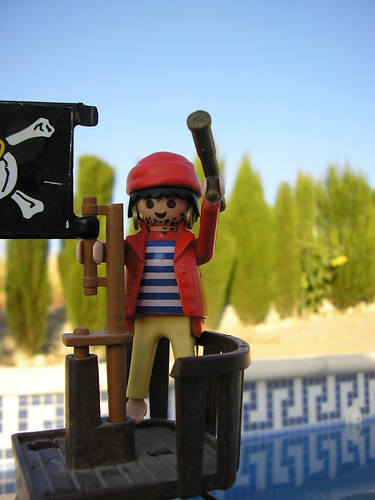
Honestly, I feel apprehensive about reviewing Dave Burgess‘s hit new book Teach Like a Pirate. I know the book and the author and his consulting group are terrifically popular with education professionals everywhere, including many teachers I respect and regularly interact with. If the masses say yay and I have a bit of a different opinion, you can decide which one of us is wrong, but I was less than impressed with TLAP.
There are many positive aspects of the book and I want to give a balanced view, so here goes. My goal is to leave you with my honest impression of the book that will help you evaluate if you should read it.
Why PIRATE?
Burgess adopts the pirate as his “mascot” because, as he says, “pirates are daring, adventurous, and willing to set forth into uncharted territories with no guarantee of success.” Wouldn’t you love to see some more “daring” and “adventurous” in American classrooms? But PIRATE is also an acronym for Burgess, referring to the essential ingredients for this type of teacher.
Passion
Passion is key to success at any job, and Burgess believes, as do I, that you can be excited about teaching, every day. Too much, you say? Well, Burgess identifies three types of passion and says you can hit at least one of them every day: content (what you’re teaching), professional (for being a teacher), and personal (hobbies). I have to admit, though, that I am one of the people that Burgess labels “freaks”: I honestly am passionate about everything in the subject I teach.
Immersion
I’m so guilty of not doing this one – especially the last two school years being pregnant the entire school year, and whenever I’m working on a big consulting project. But as Burgess says, if you’re completely present and with your students while you’re teaching, regardless of activity, you’ll be more effective, and students will recognize it, and it will create an amazing…
Rapport
In my opinion, this is one of the most prevalent characteristics in effective teachers. Developing a relationship with your students will motivate them, control behavior problems, and really, change their lives by showing them that someone truly cares.
Ask and Analyze
I love this one – Burgess tells you (and I second it!) that everyone can be creative. If you think my ideas are amazing and I’m some sort of talented super exception, you’re wrong. I promise you have creative ideas in you too – and Burgess helps you ask the questions that get you using them.
Transformation
Do you lack a sense of direction? Have a vision of what your ideal classroom looks like; then you can start creating it. Position your content as if it’s amazing (and in world languages, it is!). Reframe your content to show how it’s relevant and valuable. Indeed, the human brain is efficient; what it doesn’t find relevant, it will get rid of.
Enthusiasm
Banish negative thoughts from your classroom. Shake off the bad days and talk to yourself and your students in such a way that you are creating an enthusiastic, energetic, positive environment.
The explanations of the PIRATE system are followed by a section designed to give you a “toolbox” to teach well– like Burgess says, “it doesn’t matter how much content you teach, it only matters how much is received.” He offers series after series of questions, well presented by themes, to get you thinking about how we can “hook” student attention and keep it (really, I’m surprised he didn’t relate the word “hook” to pirates- it’s a good pun). As a quick example, one question has to do with what you can be showing or write on the board for students to see when they come in, before class starts. I used this “hook” the other day as my lesson plan called for our first nerve-wracking practice on the difficult AP interpersonal conversation task. The interviewer we were supposed to respond to was asking about reincarnation. So, I had this displayed before the lesson and students found it intriguing and funny – and engaging, the point of a “hook.”
Shaky presentation, shaky foundations
BUT… and here’s the but. Dave Burgess tries really hard to maintain a positive note of “I believe in teachers,” but I was really bothered by his off-and-on commentary on teachers who may be less passionate or those he calls “misguided and ill-informed critics [who] steal your enthusiasm.” (Or those who are good professional speakers but he’s sure they’d “get their ass kicked” in a real classroom; “sorry to say it, but you know I’m right,” “I know I’m being harsh, but I’m trying to make an important point.” But, of course, “we are all on the same team.” )
I don’t know Mr. Burgess, but I found his writing, as a professional education book, at times unnecessarily brutal, frequently arrogant, and almost always shallower than my preference in the genre.
Lacking in professionalism
I won’t go on at length, but my chief complaints here:
- You should hint that things in your content are inappropriate in order to grab and maintain attention (though, of course, the content would never be so).
- Twice Burgess brings up the subject of faking passion and both times his most appropriate illustration is Meg Ryan’s “faking” scene from When Harry Met Sally. He starts out an early chapter by promising you the secret to becoming a better lover – and often uses this “hook” on a sign outside his professional development seminars.
- All examples of games involve students pretending to kill each other.
- I’m old-fashioned. I don’t pick up a professional development book to hear about someone who may “get their ass kicked,” “I pride myself on flat out bringing it” [emphasis his], “they should have told the students to get it out before starting the damn story,” “don’t buy into this B.S.” and so on.
Lacking in humility
Dave Burgess writes, “My list of inadequacies in the classroom could go on to… embarrassing lengths,” but reading TLAP, you will have no doubt that Dave Burgess believes he is a great teacher. I’m sure he is. I’m sure I’d like to have my children in his class. But in my experience, truly great people don’t have to talk about it quite so much. I found his descriptions of his seminar performances particularly tedious and manipulative. And I disliked the presentation of the letter he wrote himself describing his class the way he wanted students to talk about it.
Lacking in support in the field
If you’ve read me for long you know that I revel in research. Maybe it’s from my SLA background in grad school where every article and paper had to start with a thorough review of the literature in the topic. I love to read the great stuff researchers are finding out about how the brain learns and how people learn language and how I can use that to make my teaching pack a real brain-based punch. I love John Medina‘s Brain Rules and Brain Rules for Baby and Daniel Pink’s Drive and Daniel Coyle’s The Talent Code. And wow, Alfie Kohn. If you have ever read Alfie Kohn you know that the bibliography is a significant portion of the book. Why? Because I can give you all the anecdotes I want but if they don’t align with the way brains actually work and kids actually learn, it’s not going to work for you.
Burgess’s support comes from self-help and marketing books. Otherwise, the book is almost completely anecdotal, so much so it reads like a memoir. Like an Amazon reviewer said, “It really reads like a self-help book for fragile and discouraged teachers,” and I agree, e.g.:
Don’t hang around negative people; they will sap your super powers.
The best way to overcome the obstacles on your path to greatness is build up enough momentum through action that you can roll right over them.
Really, the lack of substantiating support in the book is my primary concern.
You can do it, They can do it
Enough negativity. I’m supposed to be thinking positive here. Burgess echoes a lot of the tenets you’ll hear repeated on Musicuentos: “Increase the fun factor,” and of course I latched onto the encouragement to “provide opportunities for autonomy and choice.” Take advantage of opportunities to teach media literacy and critical thinking. “An effectively told story might become the most powerful thing you do in front of any audience.” He echoes my sentiment that there’s a problem with teachers going “too far towards a love affair with technology just for the sake of technology.”
You’ll remember the end of this review better than the rest so I’ll end with what I believe is the big, big message all of us need to hear and say. Burgess is a teacher who believes what every teacher in every classroom should believe: Every student can succeed. I’m afraid, somewhere along the way, we started to think that kids without the right IQ or the right home life or the right amount of money in the bank just can’t succeed. Maybe the statistics say they probably won’t. But that doesn’t change the fact that they can. Show your students that all their gifts and talents are valued. You respect and honor their individuality. The Great American Classroom has become a place that kills creativity in the name of Every Child Is The Same, but conformity is not your goal. You respect and honor your students’ individuality and show them how using it makes them more successful. Foster their strength of character and courage (I’m currently reading How Children Succeed, which cites a whole lot of research indicating these traits have more to do with children’s ultimate success than cognitive skills). Encouragingly, he at least claims to believe this about teachers too:
Today I am thoroughly convinced that any teacher who is willing to put in the time, care, and effort can transform their classroom and their life as an educator using these methods.
Good reminders for good teachers
As a few reviews on Amazon point out, you may find the book validates what you’re already trying, or simply reminds you to be enthusiastic and have rapport with students. I know that when I don’t get my technology ready ahead of time I lose my students while I do it in the middle of class and I have to regain attention and momentum, but it’s a good reminder for me. Like Burgess says, there is no single answer for how to fix your classroom, and TLAP is no exception, but if you are a passionate teacher who strives for creativity and wants to reach every student, you will find some validation and some good ideas you may not have thought of in TLAP. If you are burned out and frustrated with a school system that wants you to be the opposite, you will enjoy Burgess’s encouragement and suggestions. Research-based or not, we could sure use some more adventure and passion in our classrooms, so why not go teach like a pirate?
This review was significantly edited in April 2017 as part of my positive path. I still feel most teachers could better spend their reading time with something else, but I wanted to be sure I was presenting my opinion in a professional way.
5 Comments
Comments are closed.





Thank you so much for this review! I appreciate your candor and honestly.
Tell it like it is!!! That took guts.
Hi. Thank you for reading Teach Like a PIRATE and taking the time to write your thoughts about it. The positive reception it has received in the World Languages community has been very gratifying. #WLtlap has become a vibrant and positive online community with many fantastic contributions and a positive and uplifting vibe. I’m proud of them for what they have built and encourage world language teachers to check it out.
There is actually little I would argue with in your review with the exception of the personal attacks of arrogance, unprofessionalism, and shallowness. Much of the rest seems to be an honest difference of opinion and expectation. A big part of the appeal of the book and one of the main reasons it has resonated widely lies in its tone and anecdotal nature. I worked hard to make sure it did not read like a typical PD book. I also love many of the books you mention which have strong research to back them and are filled with multiple professional references. That’s just not the book I set out to write. It is, as you correctly note, a much more personal book based on my experiences of working with challenging classes for the last 17 years.
Thanks for also noting where you agree with the book and where it validates some of your own work, as well. For what it’s worth, it also bothers me that the double reference to When Harry Met Sally slipped in…unintentional. Another small point, the Betty Friedan reference you mention has nothing to do with sex or sexual dissatisfaction, which you seem to imply.
Thanks again for writing about #tlap. Have a great school year.
Dave
Thanks for commenting on the review, Dave. You’re right, the #wltlap network is filled with great teachers, many of them personal friends, talking about ways to really engage learners. If my evenings weren’t consumed with baby care I’d probably be joining them often.
I tried to avoid a “personal” attack by making sure I mentioned this was my opinion about you as a writer (not as a teacher, being that I have never seen you teach, or present for that matter) and coming from my personal preference in reading professional books. So, I made that clause bold and underlined above to emphasize it.
You’re right, I was misled by the Friedan reference, but I doubt that was unintentional and I think most people unfamiliar with her book would be as well, because the reference itself is faulty. I edited to explain this further above.
I also added an example of how your “hook” suggestions helped me engage students last week (you’ve already seen it on Twitter).
This year, students began their rough drafts by hand and have transfered their rough drafts onto the computer using Google Docs. In previous years, students had typed up their stories using Microsoft Word or Power Point. Change can be good. Today, most of my students had never experienced the power behind Google Docs and how all of their ideas can be simultaneously written in the same document. While the students were typing, I was able to go into the document and make some helpful remarks, questions or changes right as they were typing. Interestingly enough, Google Docs has also incorporated “voice comment” capabilities- so you can leave voice commentary or feedback for your students on the document that has been shared with you. After school, I proceeded to continue with editing and found that students were logged in from home, using the ‘chat” feature to ask me questions about their writing. We collaborated about Spanish narrative writing both in school and out of school, thanks to technology.